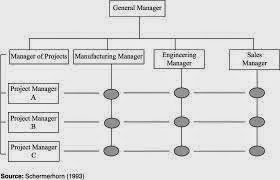KEY TERMS OF MANAGEMENT FROM ENTREPRENEURSHIP TO PROGRAMMED DECISION
1.
Entrepreneurship: The process of engaging in business ventures
that require acquiring and organizing resources, assuming risks, and reaping
rewards.
- Entrepreneur: An individual who recognizes a business opportunity and acts to capitalize upon it.
- Intrapreneur: An individual who seeks and acts upon opportunities within an organization.
2. Organizational planning
- Goal: A future state an organization desires to achieve.
- Plan: A design of the actions, resources, and personnel that will achieve a goal.
- Planning: Determining actions that will achieve an organization’s goals.
3. Organizational goal setting
- Mission: An organization’s purpose.
- Mission statement: A broadly stated expression of an organization’s unique business scope and operations.
- Strategic goals: Broad statement of the desired future position of an organization as a whole.
- Strategic plans: Actions an organization intends to take to achieve its strategic goals.
- Tactical goals: Goals set for major departments in an organization designed to achieve strategic objectives.
- Tactical plans: Actions that major departments must accomplish to achieve tactical goals.
- Operational goals: Specific results expected from departments, groups, and individuals with in an organization.
- Operational plans: Specific actions developed to support tactical goals.
4. Management by Objectives: A system by which specific goals are set by the entire workgroup, a timeline is established, and feedback on progress is ongoing. • Also known as MBO. .
5. Shewhart cycle: Quality management planning cycle used for organizational improvement that includes:
• Plan: Determine desirable changes and prepare for implementation.
• Do: Execute the changes.
• Check: Observe the result of the changes.
• Act: Perform analysis of the changes and implement broadly.
6. Single-use plans: Plans developed for goals that will only be set once.
7. Standing plans: Plans developed for guiding tasks that are performed repeatedly.
8. Contingency plans: Plans that spell-out an organization’s response to specific, pre-determined events.
9. Strategic management: Actions and guidance that serve to formulate organization-level strategy for the purpose of achieving competitive success.
10. Strategy: Plan of action that details resource allocation, labor, marketing, and capitalization required to achieve organizational goals.
11. Core competence: A business aspect upon which an organization identifies itself.
12. Synergy: Occurs when the elements of an organization produce an outcome that is greater than all of the elements acting independently.
13. Situation analysis: The evaluation of strengths, weaknesses, opportunities, and threats affecting the organization.
14. Differentiation: Competitive strategy whereby an organization strives to distinguish its products from its competitors’.
15. Cost leadership: Cost-control strategy an organization undertakes to maximize efficiency and minimize costs to increase competitiveness.
16. Focus: Competitive strategy that is characterized by concentration on a particular group of potential customers.
17. Product life cycle: The stages a product endures, from development and introduction, through maturity and growth, and finally to decline.
18. Decision: A choice made from various alternatives.
19. Decision-making: The process of identifying problems and plausible solutions.
20. Programmed decision: A decision made as a result of a situation that occurs on regular basis.
- Entrepreneur: An individual who recognizes a business opportunity and acts to capitalize upon it.
- Intrapreneur: An individual who seeks and acts upon opportunities within an organization.
2. Organizational planning
- Goal: A future state an organization desires to achieve.
- Plan: A design of the actions, resources, and personnel that will achieve a goal.
- Planning: Determining actions that will achieve an organization’s goals.
3. Organizational goal setting
- Mission: An organization’s purpose.
- Mission statement: A broadly stated expression of an organization’s unique business scope and operations.
- Strategic goals: Broad statement of the desired future position of an organization as a whole.
- Strategic plans: Actions an organization intends to take to achieve its strategic goals.
- Tactical goals: Goals set for major departments in an organization designed to achieve strategic objectives.
- Tactical plans: Actions that major departments must accomplish to achieve tactical goals.
- Operational goals: Specific results expected from departments, groups, and individuals with in an organization.
- Operational plans: Specific actions developed to support tactical goals.
4. Management by Objectives: A system by which specific goals are set by the entire workgroup, a timeline is established, and feedback on progress is ongoing. • Also known as MBO. .
5. Shewhart cycle: Quality management planning cycle used for organizational improvement that includes:
• Plan: Determine desirable changes and prepare for implementation.
• Do: Execute the changes.
• Check: Observe the result of the changes.
• Act: Perform analysis of the changes and implement broadly.
6. Single-use plans: Plans developed for goals that will only be set once.
7. Standing plans: Plans developed for guiding tasks that are performed repeatedly.
8. Contingency plans: Plans that spell-out an organization’s response to specific, pre-determined events.
9. Strategic management: Actions and guidance that serve to formulate organization-level strategy for the purpose of achieving competitive success.
10. Strategy: Plan of action that details resource allocation, labor, marketing, and capitalization required to achieve organizational goals.
11. Core competence: A business aspect upon which an organization identifies itself.
12. Synergy: Occurs when the elements of an organization produce an outcome that is greater than all of the elements acting independently.
13. Situation analysis: The evaluation of strengths, weaknesses, opportunities, and threats affecting the organization.
14. Differentiation: Competitive strategy whereby an organization strives to distinguish its products from its competitors’.
15. Cost leadership: Cost-control strategy an organization undertakes to maximize efficiency and minimize costs to increase competitiveness.
16. Focus: Competitive strategy that is characterized by concentration on a particular group of potential customers.
17. Product life cycle: The stages a product endures, from development and introduction, through maturity and growth, and finally to decline.
18. Decision: A choice made from various alternatives.
19. Decision-making: The process of identifying problems and plausible solutions.
20. Programmed decision: A decision made as a result of a situation that occurs on regular basis.



Comments